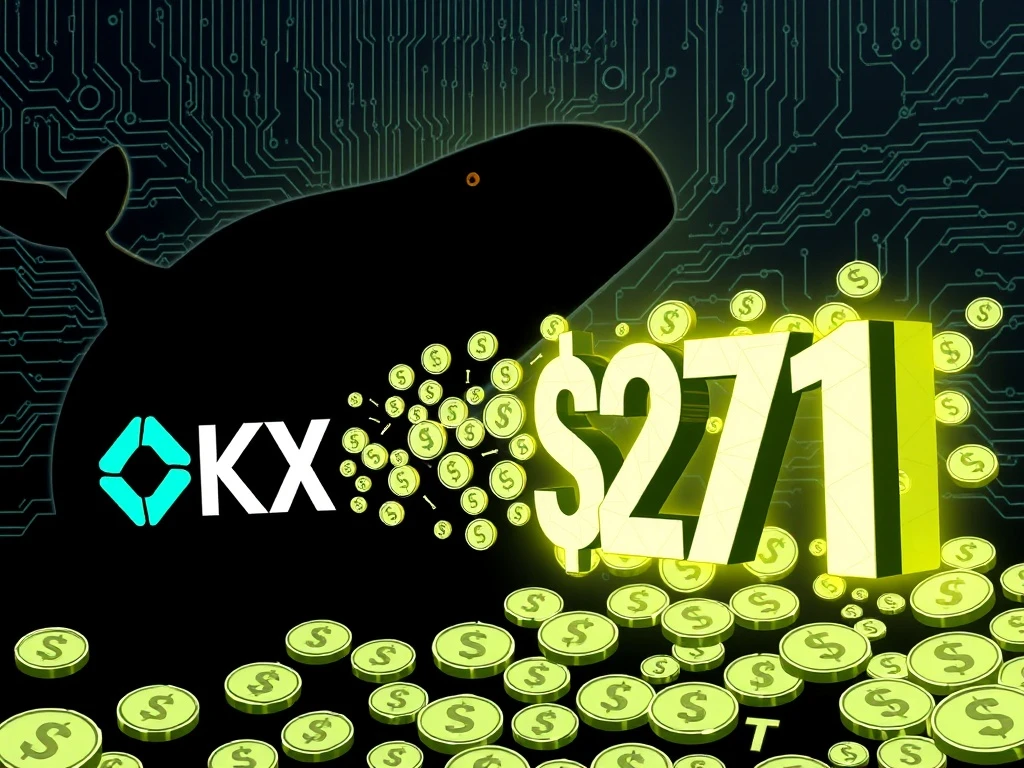USDT Transfer Unleashes Critical Crypto Market Speculation After $271M OKX Move

A colossal wave just hit the crypto shores, sending ripples of intrigue across the digital asset landscape. A staggering $271 million USDT transfer from the OKX exchange has ignited fervent speculation, leaving market participants buzzing about its potential implications. This isn’t just a routine transaction; it’s a financial tremor detected by blockchain analytics firm Whale Alert, prompting urgent questions about liquidity, strategy, and the unseen forces at play in the ever-evolving cryptocurrency market.
Understanding the USDT Transfer: A Deep Dive
The crypto world watched closely as a massive 270,660,018 units of USDT, Tether’s dominant stablecoin, moved from OKX to an unidentified wallet. This isn’t pocket change; it represents a significant slice of Tether’s total circulating supply, underscoring the sheer volume of capital flowing through the digital economy. The lack of transparency regarding the recipient wallet is precisely what fuels the intense curiosity. Is it an institutional giant rebalancing its books? A strategic play by a high-net-worth individual? Or something else entirely?
This particular USDT transfer highlights several critical aspects of the blockchain ecosystem:
- Scale of Capital: Such large movements demonstrate the immense financial capacity and liquidity within the crypto space.
- Role of Stablecoins: USDT acts as a crucial bridge, facilitating rapid transfers between fiat and digital assets, and enabling diverse trading strategies.
- On-Chain Visibility: Tools like Whale Alert provide real-time, albeit often anonymous, insights into these significant transactions, offering a glimpse behind the curtain of market dynamics.
The Role of OKX Exchange in the Transaction
OKX is one of the world’s leading cryptocurrency exchanges, facilitating billions in daily trading volume. When such a substantial sum departs from a major platform like OKX exchange, it naturally raises questions. Is the platform’s liquidity being impacted? Is this a standard operational adjustment, or does it signal a more profound strategic shift?
Exchanges routinely handle large transfers for various reasons:
- Security Rebalancing: Moving funds between “hot” (online, easily accessible) and “cold” (offline, highly secure) wallets is a common security practice.
- Over-The-Counter (OTC) Trades: Large block trades often occur off-exchange to minimize market impact, with funds transferred directly between parties.
- Institutional Withdrawals: Large institutions or high-net-worth individuals might withdraw significant sums to deploy them elsewhere, whether for investment, hedging, or other financial maneuvers.
The key distinction here is the unidentified nature of the receiving wallet. While an internal rebalance or an OTC trade is plausible, the anonymity keeps the door open for other interpretations.
Decoding Crypto Market Reactions and Sentiment
Any large, unexplained movement in the crypto space tends to generate ripples of speculation, and this $271 million event is no exception. The crypto market is inherently sensitive to perceived shifts in supply and demand, and a transfer of this magnitude can certainly influence sentiment.
- Potential Bullish Signal: If the funds are intended to purchase other cryptocurrencies (e.g., Bitcoin or Ethereum), it could signal an impending surge in demand, potentially driving prices upward.
- Potential Bearish Signal: Conversely, if the funds are being moved to facilitate large-scale OTC sales of other assets, it could suggest a bearish outlook or a desire to exit positions without causing market disruption.
- Uncertainty for Retail Investors: For the average retail investor, such events often create a sense of heightened uncertainty. Without knowing the ‘why,’ it’s challenging to interpret the ‘what next.’
It’s vital for investors to remember that a large transfer of stablecoins doesn’t inherently signal a bullish or bearish trend. It’s the subsequent deployment of those funds that truly matters.
Navigating Stablecoin Liquidity Concerns
Stablecoins like USDT are the backbone of much of the crypto trading world, offering stability amidst volatile digital assets. They ensure liquidity and ease of transfer. A sudden, massive withdrawal, however, can briefly impact the perceived stablecoin liquidity on a specific exchange, even if the overall market liquidity remains robust.
Consider these aspects of stablecoin liquidity:
- Market Depth: Stablecoins ensure there’s always a readily available asset to trade into or out of, preventing illiquidity.
- Arbitrage Opportunities: Large stablecoin movements can sometimes create temporary price discrepancies across exchanges, leading to arbitrage opportunities for sophisticated traders.
- Ecosystem Health: The smooth functioning of stablecoins is crucial for the overall health and efficiency of the crypto ecosystem. Any perceived disruption can cause concern.
While this particular transfer doesn’t necessarily indicate a systemic stablecoin issue, it highlights how closely market participants watch these foundational assets.
The Influence of Crypto Whales: What Does It Mean?
The term “crypto whales” refers to individuals or entities holding vast amounts of cryptocurrency. Their movements, due to their sheer scale, can significantly influence market dynamics. This $271 million transfer is a prime example of a whale-level transaction.
The impact of whales is a perennial debate in the crypto space:
- Market Manipulation Concerns: Some argue that large, anonymous whale movements can be used to manipulate prices.
- Legitimate Business Operations: Others contend that these are often legitimate operations by institutions managing large portfolios, rebalancing, or executing private trades.
- Transparency vs. Anonymity: Blockchain provides transparency of transactions but maintains anonymity of participants, creating a fascinating dynamic where data is public but intent is private.
For retail investors, the key takeaway is not to panic but to understand that such large movements are a constant feature of the crypto market. Instead of reacting impulsively, focus on broader market trends, fundamental analysis, and your own risk management strategy.
Actionable Insights for Investors:
- Context is King: While on-chain data like Whale Alert provides valuable real-time insights, always consider it within the broader market context. Look at overall volatility, macroeconomic factors, and regulatory news.
- Diversify: Don’t put all your digital eggs in one basket. A diversified portfolio helps mitigate risks associated with sudden market fluctuations.
- Risk Management: Have a clear trading plan, set stop-losses, and never invest more than you can afford to lose. Whale movements can exacerbate volatility, making sound risk management even more critical.
- Stay Informed, Not Obsessed: Keep abreast of market news, but avoid making impulsive decisions based solely on a single large transaction.
The $271 million USDT transfer from OKX serves as a powerful reminder of the dynamic and often opaque nature of the cryptocurrency market. While the exact motivations behind this colossal move remain speculative, it underscores the significant role of stablecoins, the influence of crypto whales, and the ongoing evolution of institutional engagement. As the digital asset landscape matures, understanding these large capital flows—whether operational, strategic, or speculative—will be paramount for anticipating future market developments and navigating its exciting, yet unpredictable, currents.
Frequently Asked Questions (FAQs)
What was the recent large USDT transfer from OKX?
A record-breaking $271 million USDT transfer occurred from the OKX exchange to an unidentified wallet, flagged by blockchain analytics firm Whale Alert. This transaction involved 270,660,018 units of the stablecoin.
Why is this USDT transfer significant?
The transfer is significant due to its immense size, representing a substantial portion of Tether’s circulating supply. It sparks speculation about its implications for market liquidity, institutional strategies, and overall market sentiment, especially given the anonymity of the receiving wallet.
What are the possible reasons behind such a large transfer?
Possible reasons include routine operational adjustments by the exchange (like rebalancing funds between hot and cold wallets for security), a strategic move by a high-net-worth entity, or the execution of Over-The-Counter (OTC) trades. The funds could also be intended for hedging against volatility or capitalizing on arbitrage opportunities.
How do “crypto whales” influence the market?
“Crypto whales” are entities holding significant cryptocurrency portfolios. Their large transactions, like this USDT transfer, can precede major trading activity. If the funds are deployed to purchase other cryptocurrencies, it could create upward price pressure. Conversely, their use in OTC sales might signal bearish sentiment.
Should retail investors be concerned about such transfers?
While large transfers can create uncertainty, retail investors should avoid making impulsive decisions based solely on these events. It’s crucial to consider market context, maintain a diversified portfolio, and adhere to robust risk management strategies, as whale movements can exacerbate market fluctuations.
What role do stablecoins like USDT play in the crypto ecosystem?
Stablecoins like USDT are critical for the crypto ecosystem. They act as a bridge between fiat and digital assets, facilitating fast and efficient trading, hedging strategies, and providing essential liquidity within the volatile cryptocurrency markets.









